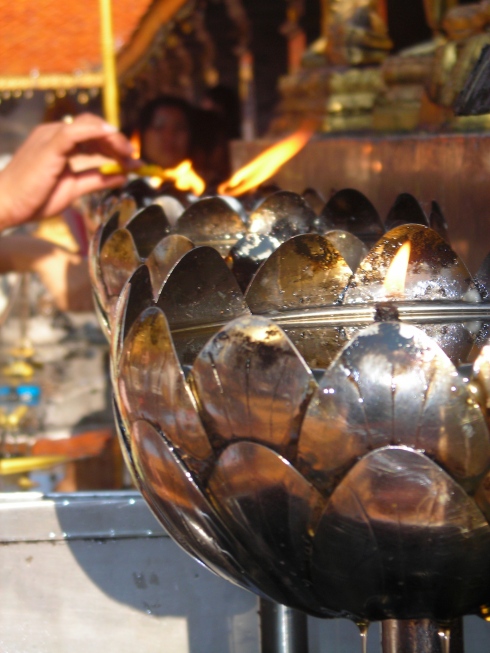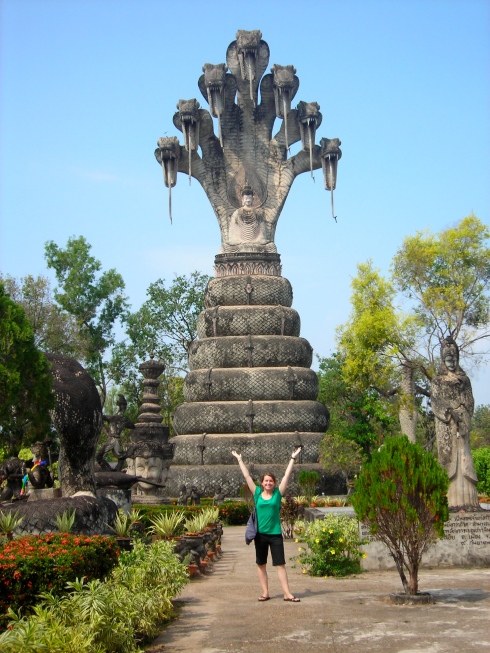This past Tuesday Thailand celebrated Wan Khao Phansa (Buddhist Lent Day), which marks the beginning of lent, a three-month period in which monks return to the temples for spiritual renewal. According to the Tourist Authority of Thailand, this aligns with the beginning of the monsoon season in a time-old tradition to keep monks from trampling the rice fields when collecting daily offerings from villagers during the growing season. It is also an opportune time for young Buddhists to enter monkhood, if even for a day, and I can testify to this tradition with the number of shaved-heads I counted among my male students this week!
For the long holiday weekend, I took the opportunity to travel with my neighbors, a family of three (a mom, a dad, and their one and a half year old daughter), to Surin. We stayed with their extended family in a small farming village about thirty-five kilometers outside of Surin, which is a town in Isaan near the Cambodian border. I first visited this town last November for the renowned annual Elephant Round-Up, which you can read about here.
This trip was quite different. For the first time since moving to Thailand I felt completely immersed in Thai culture. I had no access to internet, I had little to no reception on my cell phone, and there were no native English speakers with whom to converse. I was completely on my own, though never alone because the extended family graciously took me and my stumbling efforts at Thai conversation all in stride. To make language matters even more confusing, I found out upon arrival that Pasa Suay (an oral dialect) is spoken in this province, of which I had no knowledge of beforehand. The name for this dialect is very similar to the Thai word for “beautiful” so for the first ten minutes as the family tried to explain this fact to me I was nodding vigorously in agreement, saying in Thai: “Yes, you do speak a beautiful language.” Oops.
Much of the weekend was spent at the village temple, one day for the 96th birthday celebration of my neighbor’s grandfather, and another for Asarnha Bucha Day, which pays homage to Lord Buddha’s first sermon. On that day I participated in a procession through the village and rice fields called nang tien (literally translating to “sit candle”) in which large yellow candles were beautifully displayed in the beds of pick-up trucks, along with village kids elaborately dressed in traditional Thai garb. The procession ended at the village temple, where the candles were prominently displayed and a prayer service was held.
My favorite part of the weekend, however, was discovering that the women of the village grew, spun, and wove silk with traditional methods. I had read that Surin province was known for its silk handicrafts but I did not expect to stumble upon the practice in an alley between rice granaries. Below is a picture of my neighbor’s mother Yaa (right) boiling silkworm cocoons over a wood fire and spinning the fibers into thread, while another woman collects the worms to eat ( if you’re wondering, they are crunchy on the outside and squishy on the inside). Behind them is a tray of silkworm cocoons; the color is tham achaat, completely natural.

From cocoon to thread, making silk in Surin
On the last morning of our visit I expressed an interest in purchasing silk fabric from my neighbor’s mother. Yaa and another relative retreated to their homes only to quickly return, presenting me with two different pieces: one olive green and burgundy fabric with a traditional Khmer pattern and the other, a striped Suay pattern of green, red and gold. The women offered them to me as gifts but I refused to accept them without payment. I asked how much the Khmer print cost and the mother said 500 THB. The women agreed to accept a payment only if I accepted the other fabric as a gift. I agreed as thankfully as possible, while one of the women flamboyantly modeled the Suay fabric as a sarong in the middle of small circle that had quickly formed throughout this encounter. I went to retrieve my wallet and to my dismay realized I only had 400 THB and some change on me. A bit embarrassed, I began to explain my situation to Yaa’s son, but he quickly waved away any concern and handed his mother the money I had to offer. “Mai pen rai,” he says. The money was accepted and I warmly thanked her for the silks.
Earlier that day, Yaa had looked at me and exclaimed “Yim yai” (smile big), which was an accurate description of me for most of the weekend, as it is my default when I am lost in Thai conversation. My cheeks were actually sore by the end of the visit from smiling so much! After we said our final goodbyes and were passing through the family rice fields towards home, I sat in the backseat of the truck holding my priceless silk gifts, again smiling. This time I wasn’t lost in conversation, just for words.








